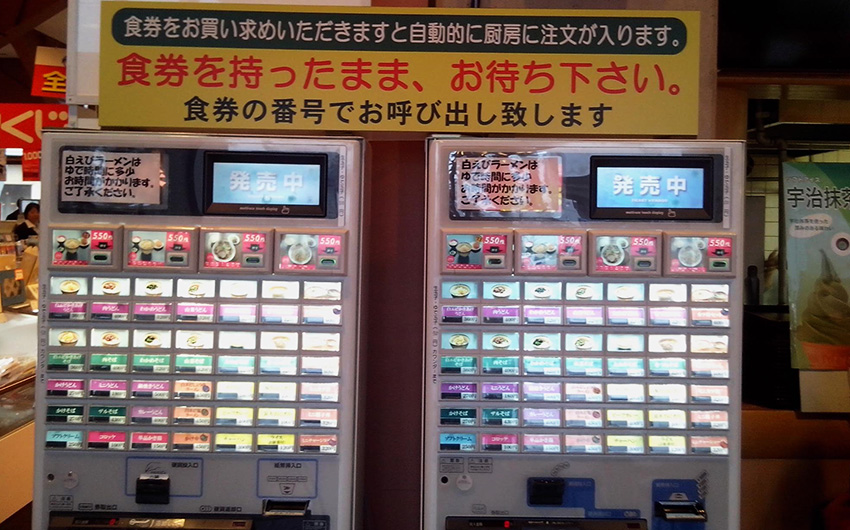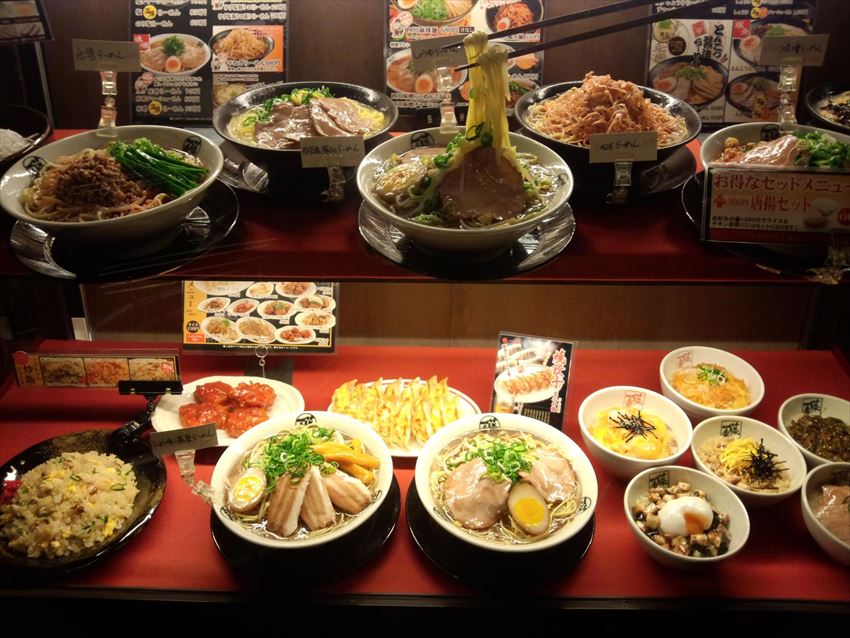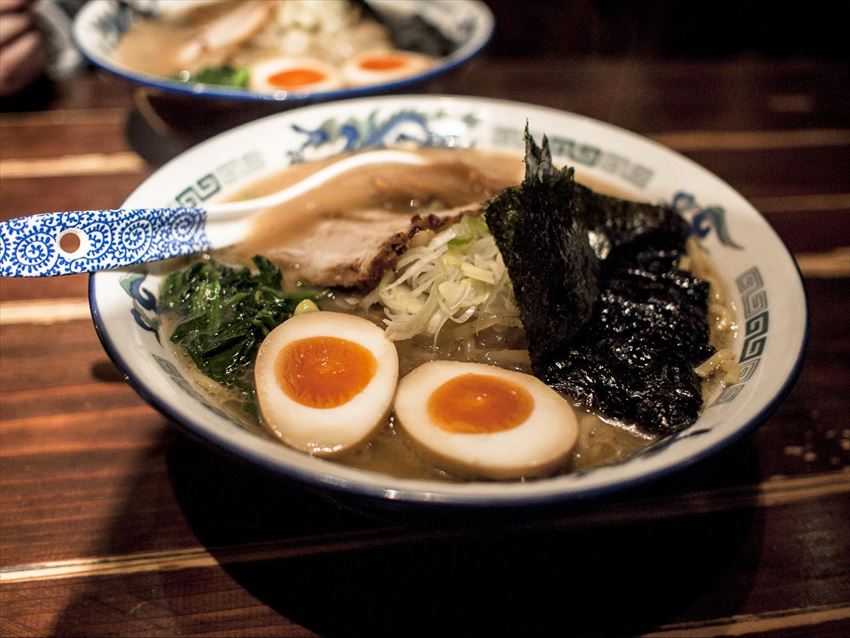
https://www.flickr.com/photos/28919802@N04/14171562083/in/photolist-nAhXFi-8Vo7oL-bphjrP-9W64KC-73WynW-bphArr-bphrMa-bph5Ni-bpgVEa-5RWijX-73Wypb-DpfuZ-8Hw4fA-cGQHBw-7MxfRg-7eywqn-7eCrwL-f4crzx-bphA1a-bphxye-919hsc-bphqRx-7eCrsb-bph1y6-a3KEQW-bpgS7R-iSiCk-a3GPAP-bphwga-bphvzp-bph6Qz-bphaPM-iSiCQ-aT5iVP-ahW2Xh-4dninF-6eXnGR-eaQaAZ-bphbu2-4HiJdj-919hkD-dvikLp-5DhmpV-7ydzi5-a3GPsF-bphnje-5UVuyz-a3GPQZ-73WyoY-7GSfCt
A ramen shop hangs it’s lantern on the sidewalk to lure customers into its warmth
Choose Your Broth
Oftentimes, ramen shops have vending machines right outside the restaurant (or in the doorway) from which you make your selection. Now this may be a daunting task, faced with all the buttons and options on a ramen shop vending machine. Here are some Japanese words that you should learn to recognize to make sure you’re buying the right thing.
醤油 (shoyu) ➜ soy sauce
Made with soy sauce at it’s core, this broth is brown and light, with a hint of saltiness.
みそ or 味噌 (miso) ➜ miso base
Miso based broth is thicker, usually a creamy white colour with a very deep and rich taste.
油 (abura) ➜ oil
This broth is made with an oil, visibly seen as droplets over the the rest of the broth. Sometimes, ramen shops may use ラー油 (rayu) chili oil instead.
塩 (shio) ➜ salt
Salt based soups are pretty straightforward. They are very salty and a slightly thinner consistency than the miso ones.

https://www.flickr.com/photos/vuhung/8437522741/in/photolist-9hnfWo-rPJHWp-4RK6pM-j4ceCk-mpNBMM-eJDCw2-ab2g8G-6WeuRb-aatkXh-5haZqS-CveedM-byEqyb-5ySDUu-5pgNY2-5PSSM7-5pM1nS-ncKPJ4-oK4J6Y-ank9eM-cVFd2y-dRAvy2-ankCRX-dRG4Rh-aaqxde-cVFfbJ-95jrew-igmTuS-cVFdhC-7548Ru-boTw11-754omU-4k4fy2
An automatic ticket machine outside a restaurant in Japan
Choose Your Noodles
Much like for the broth, here you’ll have several options in regards to noodle types. Ramen bowls can be made with a variety of noodles, so make sure to make a mental note of which ones you like.
そば (soba) ➜ buckwheat noodles
Traditionally, soba noodles are handmade and eaten cold with a small dipping bowl however, you can ask to have these healthier noodles in your bowl to make for a lighter meal.
うどん (udon) ➜ Flour noodles
Udon are thick flour noodles, usually served in a very light broth. Some people like to have udon in their ramen because they are even more filling than the other types.
麺 (men) ➜ Traditional-style ramen noodles
These noodles are the ones you’re probably most familiar with. They’re thin and wavy and have a yellowish colour.

https://www.flickr.com/photos/41265963/10753895524/in/photolist-hohwtN-bFJLKK-a3KEHu-bDssTp-pgFzx9-fJRxn9-e1qxrJ-amyf5i-nAhXFi-8Vo7oL-bphjrP-9W64KC-73WynW-bphArr-bphrMa-bph5Ni-bpgVEa-5RWijX-73Wypb-DpfuZ-8Hw4fA-cGQHBw-7MxfRg-7eywqn-7eCrwL-f4crzx-bphA1a-bphxye-919hsc-bphqRx-7eCrsb-bph1y6-a3KEQW-bpgS7R-iSiCk-a3GPAP-bphwga-bphvzp-bph6Qz-bphaPM-iSiCQ-aT5iVP-ahW2Xh-4dninF-6eXnGR-eaQaAZ-bphbu2-4HiJdj-919hkD-dvikLp
An appetizing array of ramen bowls and side dishes
Choose Your Topping
So now you’ve selected your base and your noodles, it’s time to wrap it all up with some toppings. Here you can select as many (or as little) as you wish. Usually, restaurants will offer a “stamina” bowl that has everything but the kitchen sink in it. If that’s not your style, you can always rely on the chef and select one of the osusume (suggested) menus.
チャーシュー (chashu) ➜ pork slices
This is an absolute must have when considering eating ramen. Chashu are thick, juicy slices of pork that sit right on top of the broth and add a meaty quality to the meal.
青ねぎ / ネギ (aonegi or negi) ➜ green onion
Add of touch of fresh greens to you bowl with some green onions. These onions are strong tasting on their own but they add a nice kick to the broth once mixed in.
メンマ (menma) ➜ fermented bamboo
This type of bamboo is absolutely delicious and crunchy to the taste. Menma is often used in Japanese cuisine and is full of vitamins and nutrients.
味玉 (ajitama) ➜ hardboiled and cured egg
These eggs are cooked to perfection, with their centers only slightly runny. Usually cured in soy sauce, they are a staple of ramen bowls and add a wonderful texture and flavour to the mix.
のり (nori) ➜ nori seaweed
You’ll find nori in a variety of meals, mostly in sushi. Here, you can have some added to your bowl to add a touch of crispness to your meal.

https://www.flickr.com/photos/jonolist/8446999415/in/photolist-dSr5CX-dxSMJ-6aFfG-5a2WXn-dw1RFn-dw1RNt-dw1RK8-hxzUH-5jCH2j-sivffM-dSwEbG-6ozg4u-5rvsmz-6XWzRy-nKhP8y-5tCuus-5jyqmT-5jyqie-bUkBRf-9sBj5P-vMUNy-4ha5Eu-7fvgsK-7dtnKZ-7JSpVN-4vAivZ-82R1jm-92HLDi-dDYJfF-dE56L5-bBPPQK-bBPPXZ-4vEqj7-5rzLJC-7r3n86-dE56b9-dE56v7-62EYM4-6a3gtR-7ADdc-dDYHZc-68HsSg-63C8T-NtL-3JDyAQ-98xfiV-dDYHN6-fWekBD-a4gmx6-cJ2mr
Imagine the possibilities, you can easily create a masterpiece tailored to your tastes!
So now you know about the ingredients that go into ramen, now go out there are try different combinations! Ramen is a wonderfully delicious and versatile meal that can be enjoyed as much in the sweltering summer as in the frigid winter. Next time you’re out in town, try popping into a small roadside ramen shop and see how the chef works right in front of your eyes.
Comments